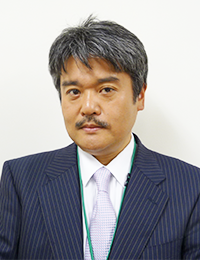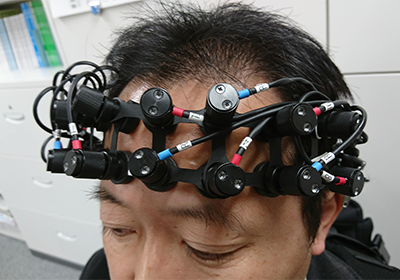キーワード: メンタルヘルス、宇宙のストレス、教員のストレス

すべての人々が孤立や排除、過酷な状況から脱することができるように援護をし、健康で文化的な生活の実現を追求する概念を、ソーシャルインクルージョンと呼びます。広く、子どもや障がい者、貧困層などの社会的弱者を社会に包摂する意味で使用されている言葉です。
ソーシャルインクルージョン・リサーチユニットは、宇宙空間で働く人々と小中学校教員を研究の対象として、ストレス測定の結果からその原因を明らかにし、人が心身ともに健康で労働に従事できる環境づくりに貢献します。
宇宙ステーションを模した閉鎖空間実験での脳のストレスを測定する

図1:NIRS装着時の写真
過酷な宇宙環境下で人が暮らすための研究はこれまでほとんど行われていませんでした。しかし、テクノロジーの進化で誰でも宇宙に行ける時代は目前といえます。火星を探索するために月からロケットを打ち上げる「Moon to Mars」計画も進み、宇宙産業が拡大する中で、宇宙で働く人々も私たちと同じ一労働者として捉え、閉鎖空間で人はどのようなストレスにさらされるのか、それを回避する方法は何かを明らかにするのがこの研究の大きな目的です。
国際宇宙ステーションを模した閉鎖空間内で約2週間にわたって生活するクルーの脳の酸素濃度をNIRS(Near Infrared Spectroscopy)という機器で測定するほか、血液循環機能、平衡機能や睡眠の変化など、多角的な観点から実験結果の分析を行いました。宇宙空間では筋骨格系の維持のために運動が欠かせません。さらに私たちの研究の結果から、15分のジョギング程度の運動を行うだけでも脳の賦活化と心理的ストレスの低減に繋がることが明らかになりました。
2020年秋からロシアで行われる200日間の閉鎖実験への参加を申請しており、審査を通過すれば、NIRSを使った新たなデータを取得し、さらなる研究の深化を目指します。この研究が進めば、宇宙空間におけるテーマパークの開設や一般の方の宇宙空間での勤務も可能になるかもしれません。
教員勤務実態調査の分析で、ストレスレスな労働環境づくりに寄与する
文部科学省委託研究公立小学校・中学校等教員勤務実態調査研究(以下、教員勤務実態調査)の3回目から当ユニットが参画し、過酷な労働環境下に置かれている公立小学校・中学校等教員調査に初めて職業性ストレスの項目を加えることになりました。
2016年に実施された最新の教員勤務実態調査によると、多くの教員が過労死ラインである月80時間を大幅に超えた残業(平日4時間、土日2~3時間)をしており、この長時間労働が常態化しています。結果として、年間5,000人もの小中学校教員が休職する事態を招いています。ストレスチェックでは公立小中学校教員の40%が不眠症であることや、その原因が長時間の通勤時間と関連していること、その他ストレスや抑うつの状況・原因が明らかになりました。
こうしたデータは、国の教育システムを審議する中央教育審議会にも報告しており、部活動の指導員や授業に特化した講師の雇用・導入の根拠として役立てられています。最近改訂されたガイドラインに、残業時間を月45時間以内、年間で365時間以内にする旨が記載されたことも、3度にわたる教員勤務実態調査の結果を受けたものと考えています。
次回の教員勤務実態調査では新たな視点を調査に加え、これまで明らかになっていない教員の不調やその要因を明らかにし、すべての教員が力を発揮できる環境が実現するよう研究を進めていきます。
社会への貢献・実績
- 国際宇宙ステーションを模した閉鎖空間における心理的ストレスの測定・分析(2015年~2020年)
- 教員勤務実態調査における職業性ストレスの測定・分析(2016年~)
取材日:2020年2月5日
Quantifying Stress under Extreme Environments to Create Healthy and Inclusive Working Environments
Unit members : Sasahara, Shinichiro Oi, Yuichi Doki, Shotaro Hori, Daisuke
Unit name: Social inclusion research unit
Keywords: Social inclusion, Social firm, Rehabilitation of depressive disease, Social withdrawal, Safety promotion
 “Social inclusion” is the concept of helping all people overcome social isolation, exclusion or other harsh situations, aiming to realize a healthy and cultural life. This term is widely used to describe the inclusion of socially vulnerable people, such as children, people with disabilities, and the poor/ people facing poverty/economically challenged people/economically disadvantaged people, in society.
“Social inclusion” is the concept of helping all people overcome social isolation, exclusion or other harsh situations, aiming to realize a healthy and cultural life. This term is widely used to describe the inclusion of socially vulnerable people, such as children, people with disabilities, and the poor/ people facing poverty/economically challenged people/economically disadvantaged people, in society.
The Social Inclusion Research Unit conducts studies, involving people working in space and elementary and junior high school teachers, to clarify the causes of stress based on the results of stress measurements, and contribute to the creation of working environments where people can work while maintaining their mental and physical health.
Measuring brain stress in a closed space simulating the International Space Station
Until now, little research has been done to devise methods to live in the harsh space environment. However, with the evolution of technology, an era when everyone can go to space will soon be arriving. As the <Moon-to-Mars Project> to launch a Mars probe from the Moon is proceeding, and the space industry is expanding, the main purpose of this research is to clarify the type of stress people are exposed to in a closed space and methods to reduce it, defining each person working in space as a worker like us/ everyone else (on earth).

Figure 1: A photograph of an NIRS device attached
In addition to measuring the oxygen concentration in the brain of crew members who lived in a closed space simulating the International Space Station for about two weeks, using a method called near-infrared spectroscopy (NIRS), we analyzed the results of this experiment from various perspectives, including changes in blood circulation, balance function, and sleep. In space, exercise is essential for the maintenance of the musculoskeletal system. Our study results also clarified that even about 15 minutes of jogging or similar exercise activates the brain and reduces psychological stress.
We have applied to participate in a 200-day closed experiment, which will start in Russia from the fall of 2020. If we pass the examination, we will be able to obtain new data using NIRS, and further deepen our research. Findings from this study may make it feasible to open a theme park in space. They may even allow the general public to work in space.
Contributing to the creation of stressless working environments by analyzing data from a survey on teachers’ working conditions
We began to participate in a survey on the working conditions of public elementary/junior high school teachers, entrusted by the Ministry of Education, Culture, Sports, Science, and Technology (teacher working conditions survey), from Period 3. With our participation, occupational stress was added for the first time to the items examined in this survey involving public elementary/junior high school teachers under a harsh working environment.
According to the teacher working conditions survey in 2016, the last period, a large number of teachers work much more than 80 extra hours a month (4 hours each weekday and 2-3 hours each Saturday and Sunday), which is the criterion of death due to overwork (“karoshi”). Thus, teachers are routinely working long hours, and, consequently, no less than 5,000 elementary and junior high school teachers take temporary leave from their jobs annually. Our stress check revealed that 40% of public elementary and junior high school teachers experience sleeplessness associated with a long commute. It also clarified the statuses/causes of stress and depression.
As a basis for employing and assigning instructors for club activities and lecturers exclusively for class sessions, these data have also been reported to the Central Council for Education in charge of reviewing national education systems. The recently revised guidelines instruct teachers not to work more than 45 extra hours a month, a total of 365 hours a year, possibly based on the results of the teacher working conditions survey that has been conducted over 3 periods.
In the next period of the teacher working conditions survey, we will adopt new perspectives to identify teachers’ health problems that have yet to be clarified and associated factors, and proceed with our studies to create environments, where all teachers can display their abilities and skills.
Social contributions and achievements
-
Psychological stress measurement and analysis in a closed space simulating the International Space Station (2015-2020)
-
Occupational stress measurement and analysis as part of the teacher working conditions survey (from 2016 onward)
Interviewed on Feb., 5, 2020
